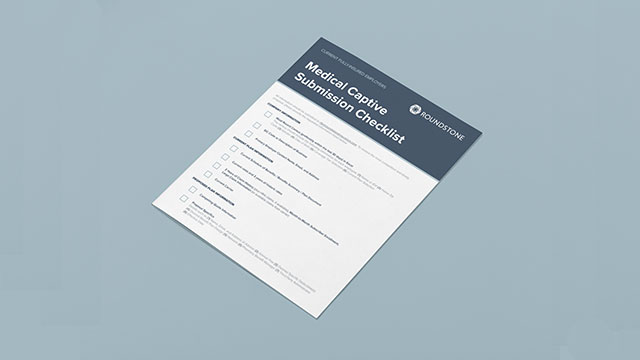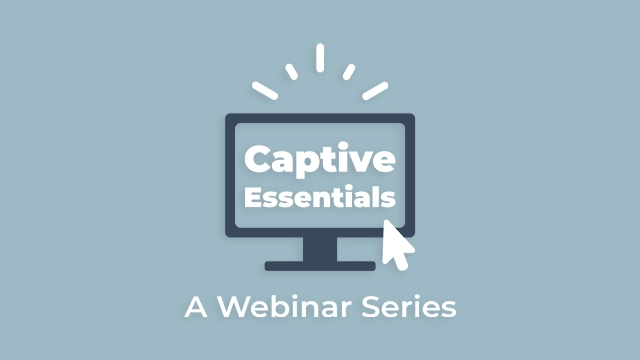Highlights
- Group medical captive insurance allows small to midsize companies to share the risk of a self-funded insurance plan while saving money and gaining control of skyrocketing expenses.
- Some self-funded health insurance solutions leverage a group medical captive. Roundstone’s group medical captive is the first of its kind, founded in 2005. The captive bands together employers in a pool so they can have the same scale and resources of a large company and effectively share the risk.
- A well-managed group medical captive model should offer your choice of third-party administrators (TPAs), prescription benefit managers (PBMs), and other cost-containment solution providers to help employers save on healthcare costs and optimize plan utilization.
- Self-funding with a group medical captive is a better alternative to traditional fully funded health insurance and even other self-funded solutions. It offers more transparency, control, stability, and savings than other options.
- Roundstone has been experiencing sustained growth that reflects a growing market for its group medical captive solution as an alternative to traditional fully insured and other self-funded options for health insurance. As the original captive – the “OC” – we take pride in the relationships we establish with our advisors and our customers. We offer unmatched customer service and share data and analytics to help you find areas of impact, so you save money while still providing competitive health insurance benefits to your employees.
Fully insured plans are not designed for small businesses, which means you end up paying more without getting the plan your employees need. This model boosts the profitability of the big insurance carriers while putting your company and staff at a disadvantage.
Self-funded health insurance plans are different. They have been used for years by over 90% of larger companies who can afford to self-fund, but smaller companies haven’t had the resources to do the same.
Group captive insurance plans offer a way for small businesses to take advantage of self-funding by banding together to manage risk while lowering costs. They can finally ditch the fully insured insurance carriers in favor of a more manageable and transparent self-funded solution.
What is Group Medical Captive Insurance?
Self-funding comes with potentially high claim volatility, so small and midsize companies have traditionally been unable to embrace this option. However, self-funded health insurance that leverages a group medical captive essentially bands together employers in a pool so they can have the same scale and resources of a large company and effectively share the risk.
By participating in a captive, employers pool a portion of their premium into a collective fund. Each employer in the group medical captive benefits from economies of scale, so they enjoy more cost-savings opportunities. They benefit individually by spending less on claims, and they benefit collectively by being part of a pool that is performing well. The group medical captive is a more cost-efficient option that doesn’t involve passing increasing costs on to employees.
How Captive Insurance Works
A captive insurance plan aims to reduce overall costs by shifting from fixed to variable costs. With fully insured small business health insurance plans, companies pay fixed costs for premiums each year. This means that they pay the full cost, regardless of whether their employees are submitting claims equal to or less than the premium.
Captive insurance, however, lets the employer keep unused funds from year to year. Fixed costs are only 15%, and the rest is variable. So, if a company’s costs are substantially lower than expected, captive insurance gives you the potential of savings from the bucket of variable costs (85%).
There are three main components to a group medical captive:
- Self-funded claims. In practical terms, with group medical captive health insurance, self-insured employers pay for all out-of-pocket claims as they are incurred instead of paying a fixed premium to an insurance carrier (a fully insured plan). Each employer participating in a captive plan will self-insure at least $10,000 of claims per member, per policy period. They only pay the amount employees spend.
- Shared risk: Employers contribute premiums to the captive pool to cover claims between the employer deductible amount and $500,000. Each employer participating in the group medical captive pool is provided with an underwritten insurance premium that is determined through their demographics and risk assessment profile — traditional insurance methodology. If there are unused premium funds from all participating employers at the end of a plan year, they are returned to the participating employers via a pro rata distribution check.
- Transferred risk: A stop-loss policy (also known as reinsurance) covers claims above the plan’s retained claims. The role of the stop-loss is to cover all claims above these employer deductible levels. When stop-loss coverage is added to a group captive plan, it spreads the risk of catastrophic claims over all members of the captive, decreasing volatility and costs for all. This covers large claims from a single individual or higher-than-average aggregate claims for all of an employer’s participating employees. Stop-loss protects against unpredictable losses. It prevents the captive participants from paying more than the maximum amounts presented in their proposal. The reinsurance layer begins at $500,000 and goes up without limit.
Group captive insurance works best for midsize companies between 25 and 500 employees.
Group Captives Offer Freedom of Choice

One of the advantages of group captives is that they allow member companies to control several aspects of their plans. One of the choices members can make is the people they choose to work with.
Those people can include:
Third-Party Administrators
A third-party administrator (TPA) is in charge of the plan’s day-to-day operations, including filing claims, reporting losses, and reviewing performance through quality control and internal audits.
It’s important to hire a TPA who meets your company’s data and claims needs while working to lower your costs. When looking to hire a TPA, consider the following:
- TPA’s claim system: Is the TPA collecting the information your company needs? Does it include basic policy information or any specialized medical coding your business uses? Does it use billing software or estimating programs to help lower your costs?
- Reports: What types of reporting does the TPA offer? Will they run loss reports? How frequently does the TPA produce reports? How are reports distributed? Can they produce customized reports for your company?
- Quality Control: Does the TPA do internal reviews of their practices and performance? Do they review claim files for compliance with their practices? How do they ensure files are handled correctly and consistently? Do they conduct an internal audit yearly? Is the audit report available for your company to examine?
Your company’s service contract with your TPA should outline all provisions and clearly explain costs.
Pharmacy Benefits Managers
The pharmacy benefits manager (PBM) is responsible for administering all prescription drug benefits. We call them a self-funded plan’s secret weapon. PBMs collaborate with prescription drug manufacturers, drug wholesalers, and pharmacies to provide employees with their medications for their contracted prices. A good PBM can help your company save money.
All insurance plans use PBM services, but your company has more choice over pharmacy benefit management services with a group captive insurance plan.
There are three types of pharmacy benefit management services:
- Traditional PBMs: They keep any savings as their own profit and are tied to your health insurance. They are not independent like the other two types.
- Transparent PBMs: They have clear contracts and are open about how their fees are structured. You can see where their revenue comes from, which makes it harder for them to take advantage of you.
- Pass-through PBMs: They collect revenue through administrative fees only. They pass manufacturer’s rebates and coupons for prescription medications on to your company, and your business keeps all the money it saves. It’s easy to anticipate your costs with a pass-through PBM.
PBMs save your company money by reducing the cost of prescription drugs. They have prescription drug knowledge and purchasing power, which can work to your company’s benefit. A PBM can find lower-cost generic drugs and work with specialty pharmacies to reduce the price of expensive brand-name medications.
Getting access to coupons, negotiating drug prices for you, and offering delivery services for prescriptions are a few ways PBMs help reduce your expenses.
They also use clinical programs like step therapy and prior authorizations to save your company money. A PBM manages your prescription drug claims and will notice any fraudulent charges.
By reducing your employee’s out-of-pocket costs for medications, the PBM helps keep medications accessible. Employees who take their medications regularly are healthier, and medication compliance can reduce your overall health insurance costs.
Insurance Benefits Advisors
An advisor, or broker, is an insurance agent. Your business will work with an insurance benefits advisor to sign up for your health insurance policy. Part of your advisor’s job is to walk you through the different options and help you select the best plan for your company.
Your relationship with your insurance advisor should be based on open communication and trust. They are your primary guide when it comes to one of your biggest line-item business expenses.
All advisors want to protect and grow their book of business, and the best agents accomplish this by offering differentiated solutions that meet your company’s needs. It’s important to work with an advisor who is consultative and understands the advantages of self-funding and a group medical captive. Beware of anyone who goes through the motions and wants to only recommend fully insured because they are only interested in doing what’s easiest for them. A consultative, data-driven advisor can speak to all health insurance models and help you decide which is best for you.
Your insurance advisor is your industry insider. It’s a good idea to prepare any insurance-related questions you have ahead of your next advisor update meeting. We’ve compiled a list of questions we recommend asking your broker to get the most out of this important relationship.
Roundstone can help you find an advisor if you need it. We have strong relationships with agents in every state who are knowledgeable about your area’s specific requirements and regulations.
Benefits of Group Medical Captive Insurance

Transitioning to a new type of health insurance can be intimidating and complex. The BUCAAs (Blue Cross and Blue Shield, UnitedHealth Group, Cigna, Aetna, and Anthem) bank on the client’s dependence on not understanding their health insurance options to keep them on the fully insured “merry-go-round” with rate increases almost every year.
Here’s how group captive insurance is different:
Improved Transparency
Trying to get information out of a fully insured insurance carrier about where your money goes and what services your employees access is challenging. With group medical captives, you control the policy, which only serves your interests and unique business needs. This gives you access to more data, such as urgent care utilization, high drug costs, and other key areas of impact that help drive down unnecessary costs.
Greater Control
In a fully insured insurance model, the insurance company controls everything, from how much you pay to what is covered in your plan and who your providers are. If something changes within your company, other than adding or losing employers, there’s nothing you can do to address it until the start of a new plan year.
Group captive insurance allows you to design a plan that is right for your business and for your employees. You are not locked into a one-size fits all plan with benefits that you won’t use. You have control over what your plan covers, ensuring your policies serve all employees and staff members.
Increased Stability
With fully insured policies, annual increases to your premiums are inevitable and often unpredictable. A recent Kaiser Family Foundation survey found that insurance premiums have risen 55% over the last decade, much faster than inflation and employee wages.
With group medical captive insurance, you control how much money you spend on healthcare, which means you can plan accordingly, ensuring greater financial health for your business and your employees. Plus, since you only pay for claims as they occur, you can significantly improve cash flow.
Reduced Costs
With the fully insured model, you pay monthly premiums to insurance companies, and 100% of those premiums are fixed. If your employees don’t generate that amount in claims, the insurance company gets to keep the difference as profit in compensation for taking on the risk.
In a group medical captive insurance program, the guiding philosophy is to help employees become smarter healthcare consumers. Because only a small percentage of your cost is fixed, the rest of your money is paid out as your employees file claims, which means that any “profit” at the end of the plan year stays in your pockets.
And with plenty of cost-containment solutions in place — including data analytics as well as wellness and concierge programs — you can reduce costs in a number of ways that are seamless to implement and create a positive experience for employees.
Risk-Sharing
Risk-sharing is the key to making group medical captives feasible for smaller businesses. When you band with other small to midsize businesses in a group captive, you share the risk of volatile claims over a larger pool of members. This allows small businesses to provide the same level of health insurance as Fortune 500 corporations.
Better Profit Potential
A good group medical captive plan can do more than help save money; it can become profitable. Our group captive plans return excess funds paid into your premiums so you can reinvest them wherever you want. Rather than worrying about annual double-digit premium increases, you can look forward to receiving a lump sum of the unused payments in your self-funded claims fund every year.
Why Roundstone is the Best Option for Your Group Medical Captive Insurance

We know you have many options for your health insurance, but as the originator of the group medical captive model, at Roundstone, we know what we’re doing. Our focus on customer relationships, level of choice, full disclosure, and cost savings sets us apart from our competitors.
Built to Serve Small to Midsize Businesses
Small and midsize businesses face different challenges from those of larger companies, especially when it comes to health insurance. Roundstone was founded in 2003 as a small business determined to help other small businesses thrive and enjoy the same advantages of larger companies in recruiting and retaining top talent.
While we’ve been fortunate to be featured as an Inc. 5000 fastest-growing company for four years in a row and are now considered a midsize company, we haven’t forgotten our roots. From starting out as a small business, we understand the challenges of balancing comprehensive healthcare with the financial needs of your business, so we work tirelessly to advocate for you and your unique needs.
We Believe in Data Transparency
At Roundstone, we’re passionate about full disclosure, unlike fully insured insurance carriers.
With Roundstone group medical captive insurance, your data is your own. You will have complete access to all data on how your employees are using their healthcare benefits through our CSI (Cost Saving Investigators) team.
With the CSI Dashboard, you will be able to see exactly where you need to expand or tighten coverage based on the needs of your employees. Our CSI Team works with you to interpret your data and identify cost-containment opportunities. Roundstone makes this data available while still upholding HIPAA statutes, so your employees’ personal health information remains private.
We Have a Top-Notch Support Team

Health insurance is a complicated topic, and we know that it can feel overwhelming. That’s why Roundstone offers best-in-class customer service to our group captive members. In addition to our CSI Team, we have Relationship Managers working for you who are always available for questions and constantly working to get you the best coverage at the lowest price.
We employ an impressive team of insurance experts so you don’t have to.
Gain Freedom and Support with Roundstone Captive Insurance
We recognize that every company is different. That means each customer we work with needs a unique insurance plan.
Unlike other companies, we give you control over your health plan and don’t limit you to certain TPAs or cost-containment solutions. You tell us what you want, and we’ll curate a plan to meet your needs.
You control your plan, allowing you to track spending and find savings. We can help you find ways to cut prescription drug costs while offering your employees the medications they need but not paying for high-cost specialty drugs they don’t use.
We can work with you to design innovative and fun employee well-being programs to reduce avoidable healthcare costs.
We aren’t afraid to think outside the box to help you control every aspect of your plan, just as you would any other business expense.
Our Medical Staff Can Help Review Your Plan
To save money, insurance companies often deny certain expensive medications or procedures without considering the medical needs of the person seeking treatment. At Roundstone, we believe high-quality care and realizing value from medical expertise is crucial to your plan’s success.
As part of your support team, we have registered nurses on staff, who help our CSI Team and TPAs negotiate the delicate balance of cost savings and quality medical care. Since they are experts in their fields, you can be confident you are saving money on claims while also providing your employees with the best possible care.
Roundstone Has a Proven Track Record of Saving Companies Money

With a fully insured insurance carrier, 100% of your costs are fixed, meaning you can’t control your spending, and the big insurance carriers keep the money you don’t use each year as profit, regardless of how much or how little your employees’ claims cost that year.
At Roundstone, we do just the opposite. We offer two opportunities for you to earn cash back each year:
- You keep unused funds in your self-funded claims account. With our group captive insurance plan, you fund your own employer deductible claims account. Any unused funds in that bank account are yours to keep. Many Roundstone clients are able to build up cash reserves, improve cash flow, and stabilize employee health plan contributions over time.
- Return of unused stop-loss premiums: These premiums go into the shared risk pool layer of your plan, and at the end of your plan year, any unused amount is returned to employers on a pro-rata basis. Last year, we refunded $10 million, 17% of the funds contributed. More impressively, that represented unused claims during an unprecedented health crisis in the COVID-19 pandemic.
Overall, 100% of our customers save money, with two-thirds reporting their savings from the first four years with us paid for their fifth year’s claims — all without shifting the financial burden of health insurance onto their employees in the form of higher shares of their premiums or increased deductibles and copays.














